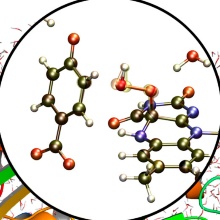A geometry optimization library for quantum chemical and QM/MM calculations to be included into electronic structure codes.
DL-FIND can be used to search for minima, transition states (the main strength of the code), and conical intersections.
Reference
Description
A light-weighted description of geometry optimization in general and DL-FIND in particular can be found in Frontiers 2007.
Functionality
Coordinate systems
- Cartesian coordinates (including frozen atoms and components), mass-weighted Cartesian coordinates
- Internal coordinates (including all constraints):
- DLC (delocalized internal coordinates, i.e. redundant internal coordinates)
- DLC-TC (total connection)
- HDLC (hybrid delocalized internal coordinates, see Phys. Chem. Chem. Phys. 2, 2177 (2000))
- HDLC-TC
Optimizers
- steepest descent
- conjugate gradient
- L-BFGS
- P-RFO, Hessian update mechanisms: Powell and Bofill. Hessian either by input or by finite-difference. In the latter case either in Cartesians (then the update also in Cartesians, and one can output frequencies), or in internals.
- Damped dynamics
- Algorithms for Conical intersection search:
- Penalty function
- Gradient projection method
- Lagrange-Newton method
- Stochastic search methods (including a genetic algorithm) for global and local minimization. These methods optimize by calculating may energies in parallel and are thus well-suited for massively parallel computation.
Line search algorithms
- Simple scaling of the proposed step (covering the maximum step length)
- Trust radius based on energy decrease
- Trust radius based on the projection of the gradient on the step
The design allows new methods to be easily implemented.
Reaction rate calculations with or without tunneling contributions
- Instanton theory (aka imaginary-F theory or harmonic quantum transition state theory) to calculate tunneling rates.
- Instanton optimizations with a quadratically-converging optimizer [4]
- Instanton rate calculations (parallelized)
- Adaptive step size in instanton calculations [5]
- Reaction rates without tunneling
Authors
- Johannes Kästner, main author
- Tom W. Keal contributed conical intersection search algorithms, parallelization of NEB and finite-difference Hessian calculations, and fixed many bugs.
- Joanne M. Carr is adding parallel search algorithms
- Judith B. Rommel contributed to the implementation of instanton theory
- Salomon Billeter and Alexander Turner: parts of their HDLCopt routines have been used in the coordinate transformation, courtesy of the Max-Planck-Institute for coal research.
- Alexander Denzel and Daniel Born contributed GPR optimisation.
- The L-BFGS code by Jorge Nocedal was used
Download
DL-FIND is distributed under the L-GPL license. The code can be downloaded at chemshell.org/dl-find/. It is written in Fortran 95. The interface to the calling program is kept slim and well-defined, which should facilitate to interface DL-FIND to various programs. Up to now, DL-FIND is included in ChemShell, GAMESS-UK, TeraChem, and a few other codes.






